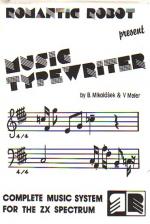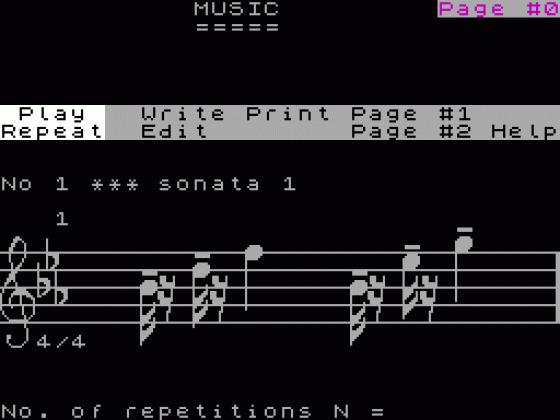
Crash
 1st December 1984
1st December 1984
Categories: Review: Software
Author: Franco Frey
Publisher: Romantic Robot
Machine: Spectrum 48K
Published in Crash #11
Music Typewriter
Converting a personal computer into a practical synthesizer usually requires a large amount of hardware - from musical keyboards to countless sound generators and filters. ROMANTIC ROBOT avoids this problem by converting the Spectrum into a music typewriter. The result is a respectable storage and retrieve type melody maker, not a realtime instrument. MUSIC TYPEWRITER stores up to 16 different music pieces within 254 bars, which can be edited and played with varying rhythm and tempo.
THE INSTRUMENTS MUSIC TYPEWRITER comes complete with a manual and a keyboard overlay in a library box. The program lets you set paper and ink colours and then presents itself with the main menu. MUSIC TYPEWRITER is organised in three program pages. For each page a help menu may be called up for on screen instructions.
Page 0 contains the main menu, which also gives access to the other pages.

Page 1 provides a selection of the key and time signatures, tempo, clef and tail display of the music to be written.
Page 2 contains the catalogue of existing music pieces and provides the controls for creating, deleting, saving and loading of other- music hors d'oevres. Throughout the program, SPACE moves the selecting cursor, ENTER executes the selected command or value, Q quits any operation and returns you to the main menu and BREAK reinitialises the program to the original colour selection.
The first excursion should lead to page 2, where the catalogue of existing music pieces will be displayed with their index number, name, number of bars and how many bars are still available. The piece to be written, edited or played is selected with NEW (for a new piece) or OLD (for an existing piece). O brings back the main menu.
The second excursion should lead to page 1, where all the key and time parameters will have to be set up for the piece to be written, unless one operates with the default values. All the major keys are available at the touch of their key. Existing music pieces will be transposed taking care of all sharps, flats etc. Any time signature may be selected from 2/4 to 8/4 or 2/8 to 15/8. Tempo can be set anywhere between 23 and 255 of the metronome scale. Treble and bass clefs and tail direction are selected for the correct notation. Pressing O returns you to the main menu where write mode may be selected. The music is written directly on the Spectrum keyboard. The overlay converts the Spectrum into a musical keyboard with the 3rd row from the top as white keys. The black keys, which can either be sharps or flats depending on notation can be accessed either on the 2nd row from the top (sharps) or the 4th row from the top (flats). There is just over 1 octave available at any time, but the whole range can be shifted an octave lower with caps shift & 2 or an octave higher with symbol shift & 2.
The shift can be cancelled by pressing caps or symbol shift & 3. There are two clefs, the bass def using the lower and the treble clef the upper part of the full 6 octave range. The basic note values are selected on the top row and range from a semibreve to a semiquaver (additional signs such as staccato, tenuto, dotted notes, triplets can also be selected) and apply until a new value is selected. The selected value is displayed in the top left corner of the screen. Pressing any of the music keys or PAUSE will play the note and display it simultaneously in the bar following the last entered note.
Caps shift & 0 deletes the notes from right to left starting with the last written note. STEP steps you through existing notes from left to right without altering them. The program takes care of the bar tines and end line. Upon completion of the music piece the write mode is left by pressing ENTER upon completion of the last bar.
The tune may now be played by selecting PLAY from main menu, and the music parameters may be changed and experimented with. REPEAT repeats a piece N times. The range is from 1 to 255 with 255 being an endless loop.
If only certain bars of a music piece need to be altered EDIT will enable you to step through and change notes in a bar number N and onwards.
CRITICISM MUSIC TYPEWRITER is an extremely user friendly program, which lets you get started within minutes. As the music has to be written in real notation, it is not suited for musicians who play by ear. You cannot play a melody with varying note values just by modulating the keys, so creating a rhythmical sequence will have to be worked out in the mind. MUSIC TYPEWRITER has tremendous potential as an educational program for young kids who have to come to grips with writing or reading a musical piece and have to team the scales. Disappointingly there is only one 'instrument' available. It would have been nice to have a range of instruments to choose from. After all, it's the one thing you expect from an electronic instrument. This together with the limitation of one voice only limits the pleasure of using MUSIC TYPEWRITER for anything more serious.
One other drawback is the way in which the notes are displayed in playback and write/ edit mode. The notes appear simultaneously when they are played or entered, but there is no forward vision. It is impossible to read (or learn to read) the notes on playback, as the preceding notes are invisible. It would have been far better to indicate the current play position by a change of ink colour using a less solid colour for the notes still to be played. The same goes for editing or writing an old piece, where you would li ke to do alterations by stepping with SPACE to copy the existing notes and to overwrite a certain section with new notes. As you are not aware of the next note you end up pressing STEP (SPACE) followed by DEL. (CAP SHIFT & 0) because of the blindness.
There is however full facility of making hard copies of your master pieces with a print command in the WRITE/EDIT mode for the current bar and in the main menu for an entire music piece. The music piece can be saved and loaded from tape by accessing page 2.
The keyboard overlay solves the problem of not having a dedicated musical keyboard and all the major commands are annotated for instant accessibility. There are a string of error reports which warn you of impending dangers and together with the HELP pages this makes for a very user friendly program.
Apart from any serious educational application MUSIC TYPEWRITER is an ideal pastime for any lingering musician. You can write the most masochist tune and see how the computer copes without any hiccups...
Other Reviews Of Music Typewriter For The Spectrum 48K
Music Typewriter (Romantic Robot)
A review by Jon Bates, Graeme Kidd (Crash)















